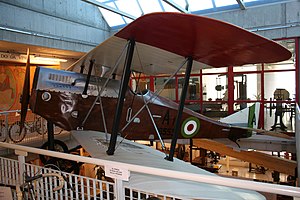Ansaldo A.1 Balilla
| A.1 Balilla | |
|---|---|
 |
|
| A.1 Balilla of Antonio Locatelli, displayed in the Museo Storico di Bergamo | |
| Role | Fighter |
| Manufacturer | Gio. Ansaldo & C. |
| Designer | Umberto Savoia, Rodolfo Verduzio, and Giuseppe Brezzi |
| First flight | 1917 |
| Number built | ~250 by Ansaldo, 57 by Lublin under licence |
The Ansaldo A.1, nicknamed "Balilla" after the Genoan folk-hero was Italy's only domestically-designed fighter aircraft of World War I to be produced in Italy. Arriving too late to see any real action, it was however used by both Poland and the Soviet Union in the Polish-Soviet War.
The A.1 resulted from continued efforts by the Ansaldo company to create a true fighter. Their SVA.5 had proved unsuitable in this role, although it made an excellent reconnaissance aircraft and had been ordered into production as such. Ansaldo engineer Giuseppe Brezzi revised the SVA.5 design, increasing the size of the lower wing, and redesigning the interplane strut arrangement, abandoning the SVA's transverse Warren truss interplane strut layout, which had eliminated the need for spanwise-exposed flying and landing wires, which the new rigging scheme re-introduced to the Balilla's airframe design. While this produced more drag, it increased the stiffness of the wing structure and reduced stresses in the airframe. Engine power was increased to 150 kW (200 hp) and a safety system to jettison the fuel tank through a ventral hatch (in case of onboard fire) was installed.
The first prototype was completed in July 1917, but acceptance by the air force did not occur until December. Test pilots were not enthusiastic in their evaluation. While they found a marked increase in performance over the SVA.5, the A.1 was still not as maneuverable as the French-built and designed types in use by Italy's squadrons, most notably the Nieuport 17, which was also produced by Macchi in Italy. This resulted in a number of modifications, including a slight enlargement of the wings and rudder, and a further 10% increase in engine power. This initially proved satisfactory to the air force, and the modified A.1 (designated A.1bis) was ordered into service with 91 Squadriglia for further evaluation.
...
Wikipedia
